阅读专题:篇章结构
初中语文阅读教案:理解篇章结构

初中语文阅读教案:理解篇章结构一、引言篇章结构是初中语文阅读中的一个重要知识点,理解篇章结构对于提高阅读理解能力和整体的语文素养非常关键。
本文将从理解篇章结构的意义、篇章结构的特点以及如何进行篇章分析这几个方面展开探讨,帮助初中生更好地掌握阅读技巧。
二、理解篇章结构的意义1. 提高阅读理解能力:了解篇章结构可以使学生在阅读过程中更好地把握文章脉络,从而提高阅读的效率。
通过对文章结构的把握,学生可以快速找到重要信息,并对文章内容进行准确而全面的把握。
2. 增强语文素养:理解篇章结构不仅有助于提高阅读理解能力,同时也能够培养学生整体把握信息和逻辑思维等综合素质。
这种对文章组织方式和内在逻辑关系的认知有助于拓宽学生思维边界,提高他们对语言文字表达方式的敏感度与反应能力。
三、篇章结构的特点1. 层次分明:通常情况下,一篇文章会由多个段落组成,而每个段落又由多个句子组成。
这些句子按照一定的逻辑关系在段落内进行排序,并通过过渡词或者句子间逻辑连接词使得整篇文章的逻辑关系更加紧密。
2. 主题明确:篇章结构通常会围绕一个主题或者一个中心思想展开,其他内容都是为了支持和阐释这个主题服务的。
因此,在理解篇章结构时,我们要着重把握作者追求表达的核心意义。
3. 文章类型多样:不同类型的文章可能采用不同的篇章结构。
例如,记叙文常采用时间顺序、空间顺序、问题解决等等方式进行组织;说明文常采用事物分类、因果关系等方式进行组织;议论文常采用排比、对比等方式进行组织。
四、如何进行篇章分析1. 段落分析法:首先,要对整篇文章进行初步浏览,了解大致内容和主题;然后将文章分成若干段落,在每个段落内寻找主旨句和承接上下文信息的过渡词;最后,分析每个段落所讲述内容的关联性,以及各段落之间的逻辑关系。
2. 关键词识别法:通过标记、圈出或者下划线来发现文章中的重点词汇,包括名词、动词和形容词等。
这些关键词可以帮助学生理解和捕捉文章的主旨信息,并且对于后续问题的回答也非常有帮助。
浅析高考阅读理解篇章结构命题思路及答题技巧

浅析高考阅读理解篇章结构命题思路及答题技巧一、“篇章结构”题型的命题分析现在,全国多个省市都采用“篇章结构”型阅读理解题(即七选五),试题模式为:给出一篇缺少五个句子的文章,对应有七个选项,要求同学们根据文章结构、内容,选出正确的句子,填入相应的空白处。
《考试说明》对该题型命题目的的表述为“主要考查考生对文章的整体内容和结构以及上下文逻辑意义的理解和掌握。
”阅读理解选择题部分的文章是完整的,在通读文章或查读细节时,思路不会被打断。
而此题型文章中有5处空白,在阅读过程中,如果不明白文章的主旨和段落主题、作者的写作意图,就很难顺畅地读下去、读明白,自然就很难选出正确答案。
而一个空填错势必又影响到对另外一个空的选择。
另外,此题有5个空白处,却提供7个选项,因此有2个选项是多余的干扰选项,从而又加大了选出正确答案的难度。
该题型要求同学们从整体上把握文章的逻辑结构和内容上的联系,理解句子之间、段落之间的关系,对诸如连贯性、一致性等语段特征有较强的意识和熟练的把握。
二、篇章结构的考查要点这一考查题型对阅读理解提出了更高层次的要求,即不仅要有阅读速度,要对所读文章的主旨要义、具体信息要有所了解,尤其重要的是要掌握作者的写作意图、观点,区分出论点和论据,并且能够把握文章的写作结构和脉络层次。
不过,只要了解了这种新题型所考查的要点,出题位置,在阅读文章时有意识地加强对文章写作思路和结构组织安排的理解,掌握英语文章常见的几种写作结构,对迅速增强此类新题型的应对能力还是非常有帮助的。
三、篇章结构解题步骤1在阅读过程中,要注意文章的开始与结束段落,尤其是文章的首段及末段末句,因为“开门见山”与“结尾总结”的写作方式为常见的写作方式,首段的末句一般是全文的主题所在,说明本文将探讨哪些内容,并简要指出文章的写作思路,有时甚至会以提纲的形式进行呈现。
首段的末句对于快速掌握文章的主题具有重要意义,如果它是文章的主题句,就可以使读者迅速明确文章情节将如何展开,并对文章的写作主题有了整体的了解。
英语阅读理解篇章结构理解技巧

英语阅读理解篇章结构理解技巧在学习英语的过程中,阅读理解是一个重要的方面。
而理解篇章的结构是提高阅读效果和准确理解文章内容的关键技巧之一。
本文将分享一些关于理解篇章结构的技巧,希望能够帮助读者在英语阅读中提高自己的能力。
一、确定文章的整体结构阅读一篇英语文章时,首先需要确定文章的整体结构。
这有助于读者对文章的组织和脉络有一个清晰的了解。
常见的结构包括但不限于以下几种:1. 时间顺序结构:文章按照时间的先后顺序来组织。
例如,描述一个事件的发展过程,或者讲述一个人的经历。
2. 问题与解决结构:文章通过提出问题,然后逐步解决问题来进行组织。
这种结构常常出现在解释性或说明性的文章中。
3. 总分结构:文章通过一个总论点,并在接下来的段落中进行进一步分析和解释。
每个段落都是总论点的一个分支。
4. 原因与结果结构:文章通过说明某些事件或情况是由其他事件或情况引起的来进行组织。
这种结构经常用于说明和推理类的文章。
了解文章的整体结构有助于读者更好地抓住文章的要点和主题观点。
二、分析段落的结构在理解篇章结构的过程中,分析每个段落的结构至关重要。
每个段落都有自己的主题,通过主题句来引出,并以支持、解释或举例来明确说明主题。
以下为一种分析段落结构的方法:1. 主题句:找出段落的主题句,它通常出现在段落的开头或结尾。
主题句将告诉我们这个段落的中心思想。
2. 支持句:主题句后面的句子或段落将会进一步支持和解释主题句。
这些句子通常提供事实、数据、例子、论据等,以增加主题句的可信性和说服力。
3. 连接词:识别段落中的连接词,如“然而”、“另外”、“因此”等,有助于理解段落内各个句子之间的关系。
通过分析段落的结构,可以更好地理解段落的内涵和意义。
三、注意文章的转折和过渡在阅读一篇英语文章时,注意文章中的转折和过渡词语,有助于理解文章的逻辑和结构。
转折和过渡词语常常出现在文章的开头、结尾或段落之间,用于引导读者从一个观点或话题过渡到另一个观点或话题。
高考英语阅读篇章结构题解题技巧

高考英语阅读篇章结构题解题技巧阅读理解占有较大的分值,把握有效的解题技巧可以有效快速解题,下面就是我给大家带来的高考英语阅读篇章结构题解题技巧,盼望大家喜爱!高考英语阅读篇章结构题解题技巧1.确定指代关系。
最常见的提问方式是:The underlined word “they/it/…” in paragraph… refers to… …2.对句子意义或作用的理解。
最常见的提问方式是:The sentence “… …” in paragraph … means ….; The example of … … in para….is used to illustrate/show … ….3.对段落大意或段落作用的理解。
最常见的提问方式是:The last paragraph mainly tell us that … …; The purpose of writing Paragraph … is …. ….4.对文章组织结构的理解。
最常见的提问方式是:How is the passage organized?;Which of the following best shows the structure of the passage?在上述几类题中考生感觉难做的题是第四类, 这类题是近两年来消失的主要考查谈论文结构的命题新方式,且逐步得到语言教育专家们的认可。
并逐步推广到对其他文体结构的考查。
分析这一类的题我们看出:对文章组织结构的考查不外乎两个层次。
一是按段落的组织方法理解文章的结构,一是按写作方法(论证方法)理解文章的结构。
首先,看看这样考查从段落层次理解文章的结构。
这类题常常用到的提问方式是:Which of the following best shows the structure of the passage? 常见的段落结构有如下几种状况:图1表明:①(Paragraph 1)是主题段(提出论题或论点),②、③段是就同一论据或者问题的同一方面作论述,④用另一论据材料或者从问题的另一方面论述,⑤段是结论段或者是用来重述论题、强调论点的段落。
高考现代文阅读篇章结构类试题答题思路文库
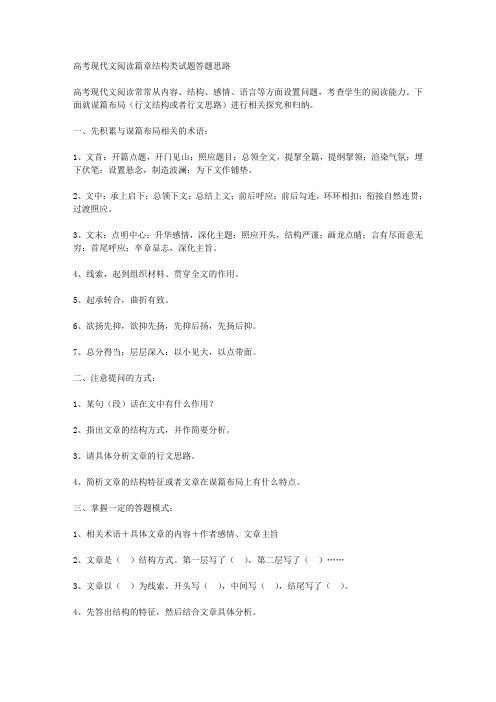
高考现代文阅读篇章结构类试题答题思路高考现代文阅读常常从内容、结构、感情、语言等方面设置问题,考查学生的阅读能力。
下面就谋篇布局(行文结构或者行文思路)进行相关探究和归纳。
一、先积累与谋篇布局相关的术语:1、文首:开篇点题,开门见山;照应题目;总领全文,提挈全篇,提纲挈领;渲染气氛;埋下伏笔;设置悬念,制造波澜;为下文作铺垫。
2、文中:承上启下;总领下文;总结上文;前后呼应;前后勾连,环环相扣;衔接自然连贯;过渡照应。
3、文末:点明中心;升华感情,深化主题;照应开头,结构严谨;画龙点睛;言有尽而意无穷;首尾呼应;卒章显志,深化主旨。
4、线索,起到组织材料、贯穿全文的作用。
5、起承转合,曲折有致。
6、欲扬先抑,欲抑先扬,先抑后扬,先扬后抑。
7、总分得当;层层深入;以小见大,以点带面。
二、注意提问的方式:1、某句(段)话在文中有什么作用?2、指出文章的结构方式,并作简要分析。
3、请具体分析文章的行文思路。
4、简析文章的结构特征或者文章在谋篇布局上有什么特点。
三、掌握一定的答题模式:1、相关术语+具体文章的内容+作者感情、文章主旨2、文章是()结构方式。
第一层写了(),第二层写了()……3、文章以()为线索。
开头写(),中间写(),结尾写了()。
4、先答出结构的特征,然后结合文章具体分析。
四、揣摩高考试题,不断加深印象,逐步使答题趋于规范。
(一)、2008四川卷《我爱水》17题(8分)文章主要写什刹海,却又从“我爱水”写起,作者为什么这样写?请简要分析。
1、一开始写“我爱水”,照应了标题,并与文章的结尾相呼应。
2、一开始写“我爱水”,可由眼前之水过渡到故都之水,使行文自然巧妙;文章的主旨是表达作者对什刹海的喜爱和思念之情,因而写什刹海的篇幅比较多。
(二)、2008江西卷《朦胧的敬意》17题(6分)指出文章的结构方式,并作简要分析。
这篇文章采用了“总-分-总”的结构方式。
1、2段总写作者对死人的不同的心理感受。
阅读理解篇章结构理解技巧

阅读理解篇章结构理解技巧
阅读理解是学习和考试中非常重要的一项技能,掌握篇章结构的理
解技巧对于提高阅读效率和准确理解文章内容非常关键。
本文将介绍
一些篇章结构理解技巧,帮助读者更好地应对阅读理解题。
1. 首先,注意文章的开头和结尾。
一篇好的文章通常会在前几句话
或者段落中提出主题,抓住重点信息。
结尾部分通常会对文章内容进
行总结或者提出结论。
通过抓住文章开头和结尾的信息,可以在阅读
过程中有一个清晰的框架。
2. 其次,注意段落之间的逻辑关系。
一篇文章通常由多个段落组成,而段落之间往往存在着逻辑关系。
这些逻辑关系可以是因果关系、对
比关系、递进关系等等。
通过抓住段落之间的逻辑关系,可以更好地
理解文章的发展和论证过程。
3. 此外,注意关键词和连词的使用。
作者在文章中通常会使用一些
关键词和连词来连接不同的观点和论证。
通过抓住这些关键词和连词,可以更好地理解文章的结构和思路。
4. 正确使用标点符号。
标点符号在文章中起到连接和分隔的作用,
通过注意标点符号的使用,可以更好地理解句子之间的逻辑关系和篇
章结构。
5. 最后,根据篇章结构进行归纳总结。
在阅读完一篇文章后,可以
对文章的结构进行归纳总结,梳理出主旨和各个部分的关系,这样有
助于深入理解文章的主要内容和观点。
通过掌握这些篇章结构理解技巧,读者可以更好地应对阅读理解题,提高阅读效率和准确理解文章内容。
实践中,读者可以多做阅读理解
练习,熟悉不同类型文章的结构和特点,不断提高自己的阅读理解能力。
阅读理解中的篇章结构分析
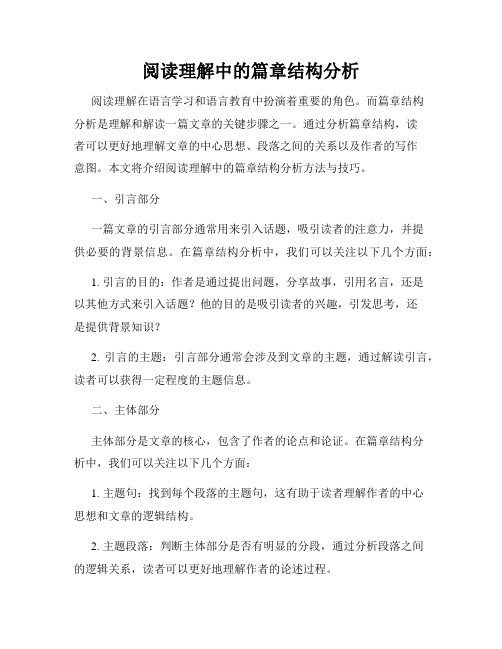
阅读理解中的篇章结构分析阅读理解在语言学习和语言教育中扮演着重要的角色。
而篇章结构分析是理解和解读一篇文章的关键步骤之一。
通过分析篇章结构,读者可以更好地理解文章的中心思想、段落之间的关系以及作者的写作意图。
本文将介绍阅读理解中的篇章结构分析方法与技巧。
一、引言部分一篇文章的引言部分通常用来引入话题,吸引读者的注意力,并提供必要的背景信息。
在篇章结构分析中,我们可以关注以下几个方面:1. 引言的目的:作者是通过提出问题,分享故事,引用名言,还是以其他方式来引入话题?他的目的是吸引读者的兴趣,引发思考,还是提供背景知识?2. 引言的主题:引言部分通常会涉及到文章的主题,通过解读引言,读者可以获得一定程度的主题信息。
二、主体部分主体部分是文章的核心,包含了作者的论点和论证。
在篇章结构分析中,我们可以关注以下几个方面:1. 主题句:找到每个段落的主题句,这有助于读者理解作者的中心思想和文章的逻辑结构。
2. 主题段落:判断主体部分是否有明显的分段,通过分析段落之间的逻辑关系,读者可以更好地理解作者的论述过程。
3. 论点和论证:分析作者的论点和论证方式,包括使用事实、例证、对比、解释等手法,以及语言的表达方式和修辞手法。
三、结论部分结论部分是文章的总结和归纳,作者会再次强调主要观点,并给出自己的观点或建议。
在篇章结构分析中,我们可以关注以下几个方面:1. 结论的内容:作者通过哪些方式总结文章的主要论点?他的结论是否有理论支持或者实证依据?他是否提供了新的观点或建议?2. 结论的呼应:分析结论与引言是否呼应,结论是否符合文章整体逻辑结构。
四、段落之间的关系在阅读理解中,理解段落之间的关系至关重要。
通过分析段落之间的逻辑关系,读者可以更好地理解作者的思路和文章的结构。
以下是常见的段落之间的关系:1. 推进关系:一个段落的观点或论证为下一个段落提供了支持或推进;2. 转折关系:一个段落的观点与下一个段落的观点存在矛盾或明显的差异;3. 例证关系:一个段落提供了一个例子或证据,为下一个段落提供了具体的实例;4. 解释关系:一个段落对前面提到的内容进行解释或说明。
新高考专题1 篇章结构,立足语篇大格局

篇章结构,立足语篇大格局篇章结构也叫文章结构。
篇章结构是作者对全文的谋篇布局,先决定主旨,布局篇章段落,然后再对段落的结构作出设计。
《英语课程标准》明确指出研读语篇就是对语篇的主题、内容、文体结构、语言特点、作者观点等进行深入的解读。
篇章结构题,是近几年高考考查的形式之一。
分析这一类题我们看出,对文章组织结构的考查有两个层次:一是按段落的组织方法理解文章的结构;二是按写作方法(论证方法)理解文章的结构。
设问方式1.How is the passage organised?2.Which of the following best shows the structure of the passage?3.The author develops the passage mainly by...?4.The first paragraph serves as a...?……考点一记叙文一、语篇结构特点记叙文的六要素:时间、地点、人物、(事情的)起因、经过和结果,即我们常说的when、where、who、why、what和how。
记叙文分为叙人和叙事两种:叙事类主要按照时间顺序(顺叙、倒叙、插叙)展开,内容包括事件的细节(details)和归纳(conclusion & comments);叙人同样按照一定的时间顺序展开,内容包括事件证明(events)和归纳(conclusion & comments)。
一般我们阅读记叙文要着重把握两条线索,即情节线和情感线,抓住两条线就抓住了文章的脉络。
记叙文的基本结构:开头(the beginning)——交代必要的背景,如时间、地点、人物等。
倒叙会在开头交代结局。
中间(the middle)——交代故事情节(事件的主体),如事件的发生、发展和前因后果。
结尾(the ending)——事件的结果或感想(the result or feeling),或对事件的分析和评价。
高中英语真题:专题7阅读理解Ⅳ:篇章结构题_1
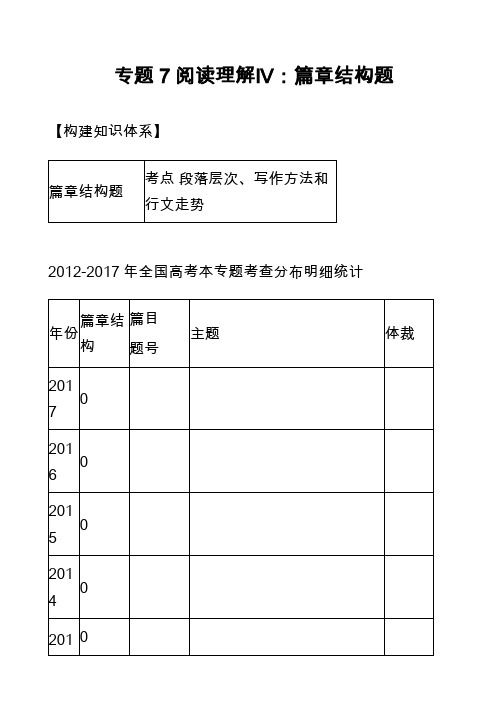
专题7阅读理解Ⅳ:篇章结构题【构建知识体系】2012-2017年全国高考本专题考查分布明细统计【考纲解读】【剖析全国高考真题】——预测高考命题方向[2012·全国卷Ⅰ,D]Grown-ups are often surprised by how well they remember somethin g they learned as children but have never practiced ever sinc e. A man who has not had a chance to go swimming for years can still swim as well as ever when he gets back in the water. He can get on a bicycle after many years and still ride away. He can play catch and hit a ball as well as his son. A mother who has not thought about the words for years can teach her daughter the poem that begins "Twinkle, twinkle, little star" or remember the story of Cinderella or Goldilocks and the Three Bears.One explanation is the law of overlearning, which can be st ated as follows: Once we have learned something, additional l earning trials(尝试) increase the length of time we will remember it.In childhood we usually continue to practice such skills as swi mming, bicycle riding, and playing baseball long after we have learned them. We continue to listen to and remind ourselves of words such as "Twinkle, twinkle, little star" and childhood ta les such as Cinderella and Goldilocks. We not only learn but o verlearn.The multiplication tables(乘法口诀表) are an exception to the general rule that we forget rather q uickly the things that we learn in school, because they are an other of the things we overlearn in childhood.The law of overlearning explains why cramming(突击学习)for an examination, though it may result in a passing grade , is not a satisfactory way to learn a college course. By cramm ing, a student may learn the subject well enough to get by on t he examination, but he is likely soon to forget almost everythi ng he learned. A little overlearning, on the other hand, is reall y necessary for one's future development.68.The author explains the law of over learning by_________.A. presenting research findingsB. setting down general rulesC. making a comparisonD. using examples【答案】68. D【解析】【高考预测】纵观近几年全国高考试题,很少出现此类题型,但这一题型在地方高考和模拟试题中时有出现,因此不排除2017年全国高考试题可能会①设置1道篇章结构题,考查考生对整个篇章或其中的某个段落结构和脉络的把握。
考研英语阅读篇章5种结构模式
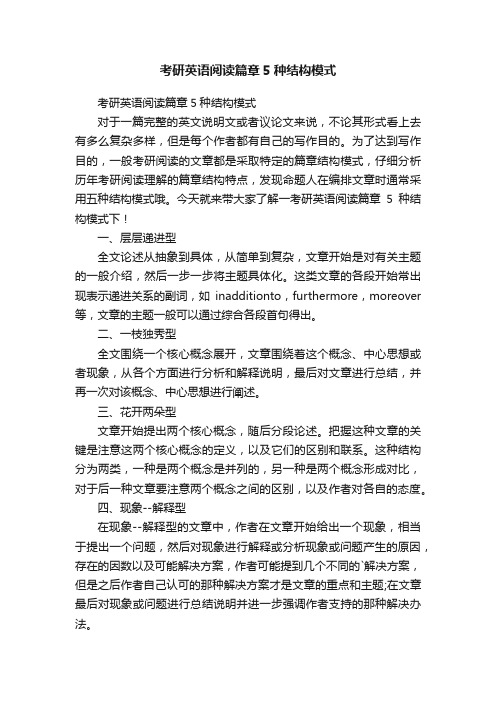
考研英语阅读篇章5种结构模式考研英语阅读篇章5种结构模式对于一篇完整的英文说明文或者议论文来说,不论其形式看上去有多么复杂多样,但是每个作者都有自己的写作目的。
为了达到写作目的,一般考研阅读的文章都是采取特定的篇章结构模式,仔细分析历年考研阅读理解的篇章结构特点,发现命题人在编排文章时通常采用五种结构模式哦。
今天就来带大家了解一考研英语阅读篇章5种结构模式下!一、层层递进型全文论述从抽象到具体,从简单到复杂,文章开始是对有关主题的一般介绍,然后一步一步将主题具体化。
这类文章的各段开始常出现表示递进关系的副词,如inadditionto,furthermore,moreover 等,文章的主题一般可以通过综合各段首句得出。
二、一枝独秀型全文围绕一个核心概念展开,文章围绕着这个概念、中心思想或者现象,从各个方面进行分析和解释说明,最后对文章进行总结,并再一次对该概念、中心思想进行阐述。
三、花开两朵型文章开始提出两个核心概念,随后分段论述。
把握这种文章的关键是注意这两个核心概念的定义,以及它们的区别和联系。
这种结构分为两类,一种是两个概念是并列的,另一种是两个概念形成对比,对于后一种文章要注意两个概念之间的区别,以及作者对各自的态度。
四、现象--解释型在现象--解释型的文章中,作者在文章开始给出一个现象,相当于提出一个问题,然后对现象进行解释或分析现象或问题产生的原因,存在的因数以及可能解决方案,作者可能提到几个不同的`解决方案,但是之后作者自己认可的那种解决方案才是文章的重点和主题;在文章最后对现象或问题进行总结说明并进一步强调作者支持的那种解决办法。
五、问题--解决方案型在这类文章中,作者首先提出一个问题,然后针对这一问题给出解决方案。
如果有多个解决方案,作者认可的才是主题。
除了文章结构外,对于报刊杂志体文章时文的一般特点也应有所了解,因为这种文章在考研阅读中占有极大比重。
报刊杂志体文章的主要特点有:1.引人入胜。
古文阅读解读篇章结构

古文阅读解读篇章结构篇章结构是古文阅读中非常重要的一部分,通过研究篇章结构可以更好地理解文章的逻辑和意图。
本文将针对古文阅读解读篇章结构进行探讨和解析。
一、引言段落引言段落是古文篇章结构的开端,作为整个文章的引子,旨在引起读者的兴趣并概括文章的主题。
在古文中,引言段落通常会使用诗句、典故或者问题引入,让读者进入文章的语境。
二、主体段落主体段落是古文篇章结构的核心部分,展开了文章的主题内容和论证。
在主体段落中,作者通常会进行思想阐述、论述观点、举例或引用相关资料等方式来支持自己的观点。
为了更好地展开内容,篇章结构可以运用以下几个常见手法:1. 整体分析法:将主题内容分为几个部分进行分析,逐一展开。
例如,如果文章的主题是“友谊”,可以从朋友的特质、友谊的重要性等不同角度进行阐述。
2. 具体事例法:通过具体的事例或案例论证观点,可以增加文章的说服力。
例如,如果要讨论“孝道”的主题,可以列举几个著名的孝子孝女的故事来说明。
3. 对比论证法:通过对比不同观点或者事物的异同点来进行论证。
例如,如果要论证“勤勉与懒惰”的区别,可以通过比较二者在工作效率、成就感等方面的差异来进行论证。
4. 类比论证法:将一个问题与其他类似的问题进行类比,从而得出结论。
例如,若要思考“忍耐力”的重要性,可以引用“水滴石穿”或者其他与之类似的事物来进行类比。
三、总结段落总结段落是古文篇章结构的收尾部分,对整个文章进行总结和归纳。
在总结段落中,作者可以回顾前文的主要内容和观点,并进行总结性的陈述。
同时,总结段落也可以适当扩展主题,提出对未来发展或进一步思考的建议。
总之,篇章结构在古文阅读中起着重要的作用。
通过了解和解读篇章结构,可以更好地理解文章的逻辑,把握作者的意图。
在阅读古文时,我们应该注重分析引言段、主体段和总结段之间的连贯性,以及段落之间逻辑推进的关系。
通过不断积累和训练,我们可以提高对古文篇章结构的理解和掌握能力,更好地解读和欣赏古文作品。
中考英语阅读理解篇章结构题单选题40题

中考英语阅读理解篇章结构题单选题40题1. In the story, which part serves as the introduction?A. The first paragraph.B. The middle paragraphs.C. The last paragraph.D. None of the above.答案:A。
本题考查记叙文篇章结构中的引言部分。
通常,记叙文的引言部分在开头,即第一段,用于引出故事主题和背景。
选项B 中间段落一般是故事的发展和高潮;选项C 最后段落通常是故事的结局或总结;选项D 不符合常规记叙文的结构特点。
2. What is the climax of the following narrative?A. The beginning.B. The middle.C. The end.D. It depends on the story.答案:B。
在记叙文的篇章结构中,高潮部分通常出现在中间。
选项 A 开头一般是引入;选项 C 结尾多是总结或留下余味;选项D 虽然有些故事的高潮不固定,但大多数情况下是在中间。
3. Which part often concludes the story?A. The beginning.B. The middle.C. The end.D. The second paragraph.答案:C。
记叙文的结尾部分常常用于对故事进行总结和收尾。
选项 A 开头用于引入;选项B 中间是故事的主体发展;选项D 第二段通常不是总结部分。
4. In a narrative, where can we usually find the background information?A. At the start.B. In the middle.C. At the end.D. Randomly throughout the story.答案:A。
阅读专题五--篇章结构

专题五篇章结构(含七选五)高频考点·探究突破《考试大纲》明确要求考生“理解文章的基本结构”。
高考对文章结构的考查主要涉及两个层次:一是按段落的组织方法理解文章的结构,二是按写作方法理解文章的结构。
把握文章的基本结构有利于理解文章的主题。
其考查主要有两种方式,一是在普通阅读理解中,二是在阅读理解第二节七选五题型中。
一、篇章结构(普通阅读理解)方法一:文章的段落组织通常采用总分;分总;总分总的框架,如下图所示:主要设题形式:①Which of the following (best)shows the organization /structure of the passage?②How is the passage organized?例1(2015·D)Technological change is everywhere and affects every aspect of life, mostly for the better. However, social changes that are brought about by new technology are often mistaken for a change in attitudes.An example at hand is the involvement of parents in the lives of their children who are attending college. Surveys(调查)on this topic suggest that parents today continue to be“very”or “somewhat”overly-protective even after their children move into college dormitories. The same surveys also indicate that the rate of parental involvement is greater today than it was a generation ago. This is usually interpreted as a sign that today’s parents are trying to manage their children’s lives past the point where this behavior is appropriate.However, greater parental involvement does not necessarily indicate that parents are failing to let go of their “adult”children.In the context(背景)of this discussion, it seems valuable to first find out the cause of change in the case of parents’involvement with their grown children. If parents of earlier generations had wanted to be in touch with their college-age children frequently, would this have been possible? Probably not. On the other hand, does the possibility of frequent communication today mean that the urge to do so wasn’t present a generation ago? Many studies show that older parents—today’s grandparents—would have called their children more often if the means and cost of doing so had not been a barrier.Furthermore, studies show that finances are the most frequent subject ofcommunication between parents and their college children. The fact that college students are financially dependent on their parents is nothing new; nor are requests for more money to be sent from home. This phenomenon is neither good nor had; it is a fact of college life, today and in the past.Thanks to the advanced technology, we live in an age of bettered communication. This has many implications well beyond the role that parents seem to play in the lives of their children who have left for college. But it is useful to bear in mind that all such changes come from the technology and not some imagined desire by parents to keep their children under their wings.70.Which of the following shows the development of ideas in this passage?I:Introduction P:Point Sp:Sub-point(次要点) C:Conclusion方法二:按写作方法理解文章的结构篇章结构类型:1、时间顺序2、空间顺序3、举例论证(数据、事例)4、对比或类比主要设题形式:The passage is mainly developed by _________.The author develops the passage mainly by ___________.How does the writer support the underlined statement in Paragraph 2?方法突破①找出文章的中心话题,找出段落的中心句。
文言文阅读中的篇章结构与段落分析方法
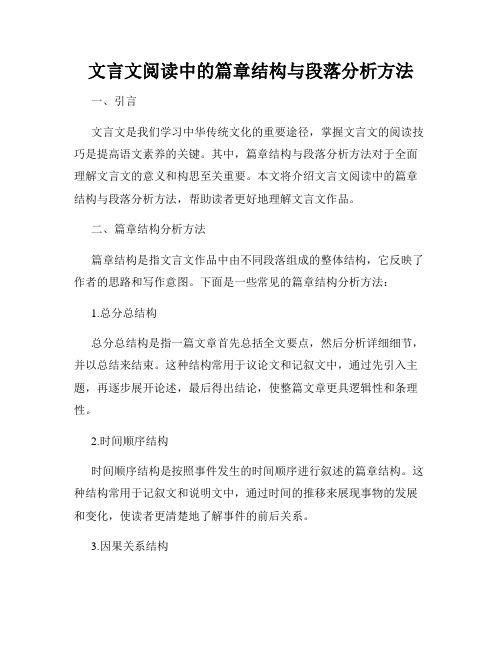
文言文阅读中的篇章结构与段落分析方法一、引言文言文是我们学习中华传统文化的重要途径,掌握文言文的阅读技巧是提高语文素养的关键。
其中,篇章结构与段落分析方法对于全面理解文言文的意义和构思至关重要。
本文将介绍文言文阅读中的篇章结构与段落分析方法,帮助读者更好地理解文言文作品。
二、篇章结构分析方法篇章结构是指文言文作品中由不同段落组成的整体结构,它反映了作者的思路和写作意图。
下面是一些常见的篇章结构分析方法:1.总分总结构总分总结构是指一篇文章首先总括全文要点,然后分析详细细节,并以总结来结束。
这种结构常用于议论文和记叙文中,通过先引入主题,再逐步展开论述,最后得出结论,使整篇文章更具逻辑性和条理性。
2.时间顺序结构时间顺序结构是按照事件发生的时间顺序进行叙述的篇章结构。
这种结构常用于记叙文和说明文中,通过时间的推移来展现事物的发展和变化,使读者更清楚地了解事件的前后关系。
3.因果关系结构因果关系结构是通过揭示事件之间的因果关系来组织文章的篇章结构。
这种结构常用于议论文和说明文中,通过解释事件间的因果关系,让读者明白事物发生的原因和结果。
4.比较对照结构比较对照结构是通过对不同事物进行比较和对照来组织文章的篇章结构。
这种结构常用于说明文和议论文中,通过比较和对照来阐述事物的异同之处,使读者更好地理解事物的本质与特点。
三、段落分析方法段落是篇章结构的基本单位,每个段落代表着一个具体的意思或论点。
下面是一些常见的段落分析方法:1.主题句/核心句分析每个段落通常由一个或多个主题句/核心句来概括段落的主旨。
分析主题句/核心句有助于把握段落的中心思想,理清段落与篇章整体的关系。
2.前后关联词分析前后关联词是连接段落与段落之间、句子与句子之间的纽带,它们可以帮助读者理解段落内外的逻辑关系。
分析这些关联词对于把握段落的发展脉络和推理思路非常重要。
3.修辞手法分析文言文中常常使用各种修辞手法来增加表达的艺术性和感染力。
阅读理解备考技巧——如何提高对文章篇章结构的理解能力
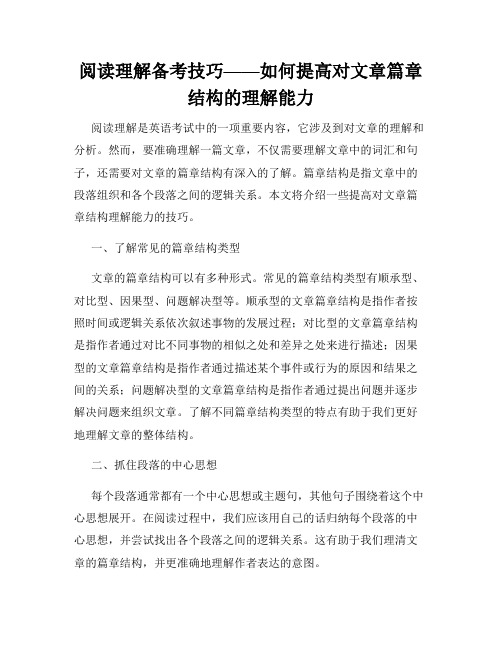
阅读理解备考技巧——如何提高对文章篇章结构的理解能力阅读理解是英语考试中的一项重要内容,它涉及到对文章的理解和分析。
然而,要准确理解一篇文章,不仅需要理解文章中的词汇和句子,还需要对文章的篇章结构有深入的了解。
篇章结构是指文章中的段落组织和各个段落之间的逻辑关系。
本文将介绍一些提高对文章篇章结构理解能力的技巧。
一、了解常见的篇章结构类型文章的篇章结构可以有多种形式。
常见的篇章结构类型有顺承型、对比型、因果型、问题解决型等。
顺承型的文章篇章结构是指作者按照时间或逻辑关系依次叙述事物的发展过程;对比型的文章篇章结构是指作者通过对比不同事物的相似之处和差异之处来进行描述;因果型的文章篇章结构是指作者通过描述某个事件或行为的原因和结果之间的关系;问题解决型的文章篇章结构是指作者通过提出问题并逐步解决问题来组织文章。
了解不同篇章结构类型的特点有助于我们更好地理解文章的整体结构。
二、抓住段落的中心思想每个段落通常都有一个中心思想或主题句,其他句子围绕着这个中心思想展开。
在阅读过程中,我们应该用自己的话归纳每个段落的中心思想,并尝试找出各个段落之间的逻辑关系。
这有助于我们理清文章的篇章结构,并更准确地理解作者表达的意图。
三、关注过渡词和连接词过渡词和连接词在文章中扮演着桥梁的角色,它们连接了不同句子和段落之间的关系。
在阅读过程中,我们要注意这些过渡词和连接词的使用,它们可以帮助我们揭示篇章结构的脉络。
例如,"因此"、"所以"等词语表示因果关系;"另外"、"相比之下"等词语表示对比关系;"首先"、"其次"等词语表示顺序关系。
四、练习篇章结构分析提高对文章篇章结构的理解能力需要不断的练习。
选择一些篇章结构较为复杂的文章进行分析,找出每个段落的中心思想,并判断各个段落之间的逻辑关系。
可以选择一些英语考试中的阅读材料进行练习,也可以找一些相关的文章或教材进行分析。
高考英语-阅读理解Ⅳ:篇章结构题(测)-专题练习(含答案解析)

2017年高考英语专题练习(七)阅读理解Ⅳ:篇章结构题(测)of Botswana’s Okavango Delta must rank as one of the world’s most exciting wildlife journeys.Several safari camps operate as the base for this adventure, providing unique rides twice a day to explore deep into the delta. The camps have excellent horses, professional guides and lots of support workers. They have a reputation for providing a great riding experience.The morning ride, when the guides take you to beautiful, shallow lakes full of water lilies, tends to be more active. It is unlike any other riding experience. With rainbows forming in the splashing water around you and the sound of huge drops of water bouncing off your body and face, it is truly exciting. You are very likely to come across large wild animals, too. On horseback it is possible to get quite close to elephants, giraffes and many other animals. The sense of excitement and tension levels rise suddenly though, as does your heart rate, as you move closer to them.In the evening, rides are usually at a more relaxed and unhurried pace, with golden light streaming across the grassy delta and the animals coming out to eat and drink. Sedate though they are, rides at this time of day are still very impressive. As the sun’s rays pass through the dust kicked up by the horses, the romance of Africa comes to life.Back at the camp you can kick off your boots and enjoy excellent food and wine. Looking back on your day, you will find it hard to deny that a horseback safari is as close as you will ever come to answering the call of the wild. 2.The author introduces the riding experience in the Okavango Delta mainly by________.A.following space orderB.following time orderC.making classificationsD.giving examples3.Technological change is everywhere and affects every aspect of life, mostly for the better. However, social changes are brought about by new technology are often mistaken for a change in attitudes.An example at hand is the involvement of parents in the lives of their children who are attending college. Surveys (调查)on this topic suggests that parents today continue to be “very” or “somewhat” overly-protective even after their children move into college dormitories. The same surveys also indicate that the rate of parental involvement is greater today than it was a generation ago. This is usually interpreted as a sign that today’s parents are trying to manage their children’s lives past the point where this behavior is appropriate.However, greater parental involvement does not necessarily indicate that parents are failing to let go of their “adult” children.In the context(背景)of this discussion, it seems valuable to first find out the cause of change in the case of parents’ involvement with their grown children. If parents of earlier generations had wanted to be in touch with their college-age children frequently, would this have been possible? Probably not. On the other hand, does the possibility of frequent communication today mean that the urge to do so wasn’t present a generation ago? Many studies show that older parents — today’s grandparents — would have called their children more often if the means and cost of doing so had not been a barrier.Furthermore, studies show that finances are the most frequent subject of communication between parents andtheir college children. The fact that college students are financially dependent on their parents is nothing new; nor are requests for more money to be sent from home. This phenomenon is neither good nor bad; it is a fact of college life, today and in the past.Thanks to the advanced technology, we live in an age of bettered communication. This has many implications well beyond the role that parents seem to play in the lives of their children who have left for college. But it is useful to bear in mind that all such changes come from the technology and not some imagined desire by parents to keep their children under their wings.3.Which of the following shows the development of ideas in this passage?()4.【贵州省遵义航天高级中学2016届高三第四次模拟】When should people be made to retire? 55? 65? Should there be a compulsory age limit?Many old people work well into their 70s and 80s, running families, countries or corporations. Other people, however, despite being fit and highly talented, are forced to retire in their fifties or even earlier because of the regulations of a company or the nation. This essay will examine whether people should be allowed to continue working as long as they want or whether they should be encouraged to retire at a particular stage.Some people think there are several arguments for allowing older people to continue working as long as they are able. First of all, older employees have an immense amount of knowledge and experience which can be lost to a business or organization if they are made to retire. A second point is that older employees are often extremely loyal employees and are more willing to carry out company policies than younger less committed staff. However, a more important point is regarding the attitudes in society to old people. To force someone to resign or retire at 60 indicates that the society does not value the input of these people and that effectively their useful life is over. Age is irrelevantto a working life, surely if older employees are told they cannot work after 60, this is age discrimination. That they become old does not necessarily mean they are going to be sick. Old people could be more aware, experienced and committed than some youngsters.Others, however, think that allowing older people to work indefinitely is not a good policy. Age alone is no guarantee of ability. Old people are only ambitious workaholics who are too selfish and self-centered to believe that a younger person could do better. Actually, many younger employees have more experience or skills than older staff, who may have been stuck in one area or unit for most of their working lives. Having compulsory retirement allows new ideas in an organization. In addition, without age limits, however, many people would continue to work purely because they did not have any other plans or roles. A third point of view is that older people should be rewarded by society for their life’s labor by being given generous pensions and the freedom to enjoy their leisure. We now have youngsters who can’t find jobs because old people are choosing not to retire. Old people are not retiring because this new gener ation of “old people” think they will never die due to modern advances in medicine.With many young people unemployed or frustrated in low-level positions, there are often calls to compulsorily retire older workers. However, this can affect the older individual’s freedom and right to work and can deprive(剥夺)society of valuable experience and insights. I feel that giving workers more flexibility and choice over their retirement age will benefit society and the individual.4.The passage is arranged as follows ________5.【陕西省咸阳市武功县2016届高三上学期摸底考试】Salvador Dali (1904-1989)was one of the most popular of modern artists. The Pompidou Centre in Paris is showing its respect and admiration for the artist and his powerful personality with an exhibition bringing together over 200 paintings, sculptures, drawings and more. Among the works and masterworks on exhibition the visitor will find the best pieces, most importantly The Persistence of Memory. There is also L’Enigme sans Fin from 1938, works on paper, objects, and projects for stage and screen and selected parts from television programmes reflecting the artist’s showman qualities.The visitor will enter the World of Dali through an egg and is met with the beginning, the world of birth. The exhibition follows a path of time and subject with the visitor exiting through the brain.The exhibition shows how Dali draws the viewer between two infinities(无限). “From the infinity small to the infinity large, contraction and expansion coming in and out of focus: amazing Flemish accuracy and the showy Baroque of old painting that he used in his museum-theatre in Figueras,” explains the Pompidou Centre.The fine selection of the major works was done in close collaboration(合作)with the Museo Nacional ReinaSofia in Madrid, Spain, and with contributions from other institutions like the Salvador Dali Museum in St. Petersburg. 5.How are the exhibits arranged at the World of Dali? ________A.By popularityB.By time and subject.C.By size and shapeD.By importance.阅读理解Ⅳ:篇章结构题(测)答案1~5 ABBAB阅读理解Ⅳ:篇章结构题(测)解析1.【文章大意】随着现代科技的发展,树荫下种植的咖啡产量越来越少,取而代之的是受到阳光暴晒的考费。
阅读专题:篇章结构PPT课件

1
考点揭秘 高考对阅读理解能力测试的要求 1.掌握所读材料的主旨和大意,以及用以说明主旨和 大意的事实和 细节。 2.既理解具体的事实,也理解抽象的概念。 3.既理解字面意思,也理解深层含义,包括作者的态 度、意图等。 4.既理解某句、某段的意义,也理解全篇的逻辑关系 ,并据此进行 推理和判断。 5.既能根据材料所提供的信息去理解,也能结合中学 生应有的常识去理解。
.
2
• 段落是文章的基本单位。
• 1. 构成段落的三个部分:主题句、扩展句(又叫支撑 句) 、结论句
• 主题句概括段落的中心思想,是段落发展的依据。
• 扩展句支持主题句,通过给出一些例子、原因、事实、 统计数字或引文等,对主题句进行解析说明,这是段 落的主体部分。
• 结论句也叫总结句,通常是段落的最后一句,与主 题句相呼应。
•
.
3
• 一.主题句:主题句反映段落的中心思想,它常常位于段首或段末,有时也可置于段中。
• 主题句呈现的形式
• 1. 文首 ----- 演绎法写作方式:文首开门见山, 提出主题, 随之用细节来解释, 支撑,发展主题句所表达 的主题思想。(先总后分)
• 2. 文尾 ---- 归纳法写作方式: 在前文表述细节后, 在文尾归纳要点, 印象, 结论,建议或结果, 以概括主 题. (先分后总)
• (3). For one thing … , For another......,
(4). On one hand … , On the other hand... 等。
• Music comes in many forms: most countries have a style of their own. Poland has its Polkas. Hungary has its czardas. Brail is famous for the boss nova. The U.S. is known for jazz, a completely original type of music that has gained world-wide popularity.
- 1、下载文档前请自行甄别文档内容的完整性,平台不提供额外的编辑、内容补充、找答案等附加服务。
- 2、"仅部分预览"的文档,不可在线预览部分如存在完整性等问题,可反馈申请退款(可完整预览的文档不适用该条件!)。
- 3、如文档侵犯您的权益,请联系客服反馈,我们会尽快为您处理(人工客服工作时间:9:00-18:30)。
Music comes in many forms: most countries have a style of their own. Poland has its Polkas. Hungary has its czardas. Brail is famous for the boss nova. The U.S. is known for jazz, a completely original type of music that has gained worldwide popularity.
•
• •
三、段落的发展 在主题句确定了以后,下一步就是运用扩展句展开主题。常用的段落发展方法有:列举法、举例法、因果法、比较对照法、分类法、综合 法等。
• • • • •
1.列举法:是指先提出论点,然后列举出一系列论据进行陈述或解析的方法。 列举法常用的过渡连接词语有: (1). First,... Second,... Also, ..., Ffinally; (2). One..., Another... , Still another..., (3). For one thing … , For another......, (4). On one hand … , On the other hand... 等。
•
• •
5.分类法: 通过对所叙述的事物进行分门别类来展开段落。
常用的词语有: to divide … into, to classify … into, according to, in terms of, on the basis of, kinds, types, sorts, groups, categories等。
考点揭秘 高考对阅读理解能力测试的要求 1. 掌握所读材料的主旨和大意,以及用以说明主旨和 大意的事实和 细节。 2.既理解具体的事实,也理解抽象的概念。 3. 既理解字面意思,也理解深层含义,包括作者的态 度、意图等。 4. 既理解某句、某段的意义,也理解全篇的逻辑关系 ,并据此进行 推理和判断。 5. 既能根据材料所提供的信息去理解,也能结合中学 生应有的常识去理解。
•
•
• •
文章或段落的主题句常常会出现在一些标志性的提示后。如:However, but, Therefore, So, Thus, In fact, On the whole, As a result, in short, I agree with the opinion that.; Given all these points above, I would support the idea that.; For all the reasons mentioned above, I would prefer.
6.定义法: 通过定义阐明事物的性质和特征来发展段落,常用于说明文、描 写文和议论文。 常用的词语有:to be defined as, to refer to, the definition of, the term, to mean, to be等。如: 7. 综合法: 以上六种段落发展的方法经常综合使用。在段落中同时交叉使 用两种或以上的方法,使段落表达得更加完整有力。
•
• • • • • • •
3.因果法: 因果法根据事物发生的原因推理其结果,或根据结果分析原因。 表示结果的常用过渡词有: therefore, as a result, accordingly, consequently, f or this reason, lead to等; 表示原因的过渡词有:
• •
3. 文中 ------ 通常前面只提出问题, 文中的主题由随之陈述的细节或合乎逻辑的引申在文中导出, 而后又作进一步的解释, 支撑或发展.
4. 首尾呼应 ------ 为突出主题, 作者先提出主题, 结尾时再次点出主题, 这种首尾呼应的写作方式较为多见. 但前后表述主题 的句子不是简单的重复, 后面的表述往往有进一步的引申或发展的意味。 5. 无主题句 ------- 即主题句隐含在全文中, 没有明确的主题句. 必须根据文篇中所提供的事实细节,进行全面考虑,综合 分析,然后找出共同的东西,归纳成一般概念。必须注意的是,既不能以偏概全,也不能在概括时过于宽泛,要恰如其分。 6. 除了以上主题句呈现的常见形式外还要特别注意标志词
due to, because of, owing to, since, as, result from, on account of等。如:
4.比较对照法: 通过比较两个或一个事物的两个方面的相似点或不同点来支持主题句。
•
• • •
常用的过渡词中比较相同点的有:
like, same, in the same way, similar to, similarly, both … and, in common 等; 对照不同点的有: however, although, but unlike, differ from, be different from, on the other hand, in contrast, whereas等。如:
•
段落是文章的基本单位。
•
•
1. 构成段落的三个部分:主题句、扩展句(又叫支撑句) 、结论句
主题句概括段落的中心思想,是段落发展的依据。
•
扩展句支持主题句,通过给出一些例子、原因、事实、统计数字或 引文等,对主题句进行解析说明,这是段落的主体部分。 结论句也叫总结句,通常是段落的最后一句,与主题句相呼应。
• • • •
二.段落的连贯:段落的连续性要求文章段落中各句要前后衔接,条理清楚,使读者易于理解。 逻辑顺序的连贯:英语的段落甚至整篇文章的内容按六种逻辑顺序排列, 分别为时间、空间、递升、递降、演绎和归纳。 如: Every morning my nephew and I took a walk in the neighboring hills where we could enjoy the fresh air and sweet songs of the birds. In the afternoon, I mostly spent my time reading or writing, for I was shut in the house by the terrible heat. The evening was the only time we could to swim together. I improved swimming during those two weeks and through physical exercise I became stronger. (按时间顺序) Give students a chance to grow. Let them seek knowledge, but do not find it for them. Let them learn patience; do not force it on them. Let them take their own time to grow; do not set rigid schedules. Experience cannot be taught; it must come slowly through person search. (归纳法)
•
2.举例法:通过具体的事例扩展段落,阐述主题句中的主导思想。
•
常用的过渡连接词有: to illustrate, besides, in addition to等。
for example/instance, in particular, such as, like,
furthermore,
also,
•
•
•
•
•
•
•
• • •
一.主题句:主题句反映段落的中心思想,它常常位于段首或段末,有时也可置于段中。 主题句呈现的形式 1. 文首 ----- 演绎法写作方式:文首开门见山, 提出主题, 随之用细节来解释, 支撑,发展主题句所表达的主题思想。(先总 后分) 2. 文尾 ---- 归纳法写作方式: 在前文表述细节后, 在文尾归纳要点, 印象, 结论,建议或结果, 以概括主题. (先分后总)
